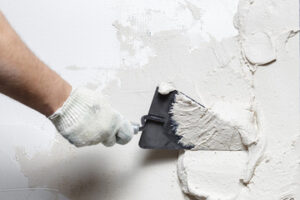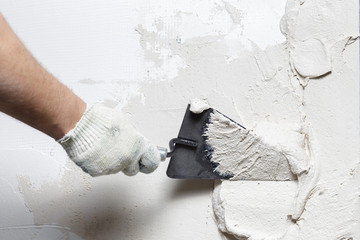Stucco can crack and deteriorate over time, but if the damage is caught early enough, Stucco Repair Philadelphia is inexpensive. Larger repairs may require remediation, which involves removing the damaged areas, installing new building paper and metal lath, and patching with three coats of stucco repair mix.
Purchase a bag of pre-mixed stucco repair mix or make your own by shoveling the dry ingredients into a wheelbarrow and mixing with a mortar hoe. Choose an acrylic bonding agent if needed.
When cracks form in your stucco, you should treat them as a priority. Though they may seem insignificant at first, they can grow over time and cause serious problems if left unchecked. They can create pathways for moisture to seep inside your walls, which leads to wood rot, mold, and other issues. They can also weaken the structure of your home, causing the beams and framing to collapse.
The most common type of crack in stucco is a hairline crack, which is usually less than 18 inches wide and occurs naturally as the plaster settles or shifts during construction. This type of crack is a normal part of settling and should not be considered a serious problem, but it can become a concern if it is allowed to get worse.
If you have hairline cracks, they should be filled with standard caulk to prevent water from entering the walls and damaging them. You can use a foam caulk, which is best for smooth stucco textures, or you can experiment with sanded caulks, which are better for rougher stucco textures. You should also apply a water-based paint to the caulking so that it matches the color of the stucco on your home.
Wide cracks are usually a sign of a structural issue and should be addressed by a professional. The problem could be that the foundation of your home has settled and needs to be underpinned using push piers or helical piers. Once the foundation has been stabilized, your cracks will disappear, and you can have peace of mind knowing that your house is safe.
For larger cracks, you will need to chisel the edges of the crack down to about a quarter inch. You should then remove any loose material from the crack and clean it thoroughly. You can then repair it with a mixture of fresh stucco. If the crack is particularly large, you will need to call in a professional who can assess the crack, determine why it formed, and address the underlying issue to prevent it from happening again.
Loose Pieces
Stucco is one of the toughest and longest-lived claddings available for homes. When properly installed and well maintained, it’s virtually bulletproof against the elements. It can last 100 years or more, but it’s important to repair cracks and holes in stucco as soon as you spot them. If not repaired quickly, they’ll deteriorate and cause more damage over time.
The first step in repairing a hole or crack in stucco is to remove loose plaster. This is usually easy, but you may need to scaffold to reach higher spots. A hammer and a cold chisel work for small jobs, but you can rent an electric chipping hammer with a masonry bit to get through thicker layers of plaster. Be sure to wear protective eyewear to avoid getting stucco in your eyes. It’s also a good idea to keep a bucket of water close at hand in case of spray from the chipping process.
Loose stucco often bulges and feels spongey to the touch. It’s often a sign of rotted framing or sheathing, so it’s important to replace these materials as well. Once you’ve done this, inspect the underlying wire mesh for signs of rust or decay. If it’s still in good condition, you can proceed with patching the damaged area of your home.
If not, you’ll need to install a new layer of building paper and metal lath. This is a major job and will require the help of a licensed structural engineer, but you can prepare for it by cutting a piece of grade-D builder’s paper to the size of your repair area. Secure it to the sheathing with roofing nails, leaving a margin of at least 6-in. on each side of the repair site.
It’s also worth noting that older stucco is likely to be lime-based instead of Portland cement-based, as is commonly used today. To check whether your stucco is lime-based, place a piece in water and see if it softens. If it does, your stucco is old and needs to be patched with a Portland cement-based stucco mix.
Large cracks the width of a penny or more are serious and indicate structural problems, so you’ll need to hire a contractor. These kinds of cracks may be caused by shifting foundations or faulty flashing. You can prevent these cracks from getting worse by installing a weep screed at the base of the wall.
Repairing larger areas
Depending on the type of base and how well it’s cared for, stucco can last up to 80 years. However, as with any material, it will eventually need some attention. If you’ve noticed signs of damage, it’s important to bring an expert out as soon as possible. Early detection can save thousands of dollars in repairs.
Stucco repair can be a relatively simple process, but it does require a bit of time to complete. First, you’ll need to clean the damaged area. Then, you’ll need to scrape away any peeling paint (a “5 in 1” or flat scraper works best). Once the surface is cleaned, check to see if it is “chalking.” If it is, it will need a binding primer. A masonry primer is a great choice.
You can also use masonry caulking to make small crack repairs. The type of caulk you use depends on the texture of your stucco. If you have a smooth texture, you should use acrylic caulking, but for rougher textures, you may want to use a polyurethane product. Both products are available at most hardware and paint stores.
For a more extensive crack repair, you can use a pre-mixed stucco repair mortar or a traditional mix of Portland cement, sand, and water. The key is to follow the manufacturer’s instructions on mixing and curing times. Then, you can add a coat of finish to match the surrounding stucco.
If you’re looking to retouch the color or fill in small hairline cracks, you can use acrylic or elastomeric paint designed for masonry. For larger areas, call a professional painter who has experience working with stucco. They can help you choose the right color and finish for your home.
Stucco is a durable and beautiful option for your home’s exterior. But, like any material, it can be damaged by harsh weather events and improper maintenance. If you see any signs of damage, bring an expert out as soon as possible to prevent the problem from getting worse.
Preparation
Stucco has a long history as a durable, beautiful, and affordable building material for homes and commercial buildings. It can be applied in a variety of textures, from smooth to rough or even patterned. Like any other building material, stucco can be damaged by many factors. But if you detect damage early, you can often save yourself the cost and hassle of a full replacement.
Often, the first sign of damage is a crack in the surface. These are usually caused by water, which seeps beneath the surface and can cause chips and soft spots. But they can also be caused by the movement of a building. For example, if the foundation settles, the cracks can widen as it moves through the masonry.
The best way to prevent future cracks is to prevent water penetration by covering the wall with a protective barrier. This can be done with an acrylic elastomer or a thick coating of pigmented caulk. The elastomer and caulk will bridge and seal hairline cracks.
Before beginning any stucco repair, you should prepare the area by removing loose pieces and cleaning it off. You should also examine the metal lath supporting the stucco to make sure it’s in good condition. If it’s deteriorating, you should replace it with new lath. Finally, you should cover the repaired area with a layer of house wrap or felt paper and secure it with staples or lath nails.
Once the repair is complete, you can paint the area to hide the patch. When painting, it’s important to use high-quality, water-resistant paint. If you don’t, moisture will penetrate the patch and eventually seep into the interior of your home or business.
There are a number of different products on the market for repairing cracks in stucco, from pre-mixed stucco repair mix that’s ready to trowel on to conventional cement and sand mixtures that you can mix yourself. Whatever you choose, it’s a good idea to follow the manufacturer’s instructions precisely. Then, before the new stain or stucco coat dries, press into it a layer of coarse sand or gravel. This will help the caulk adhere to the wall and keep it in place.

